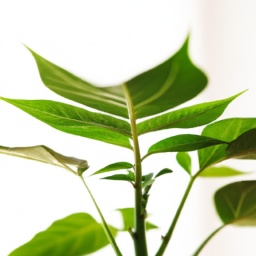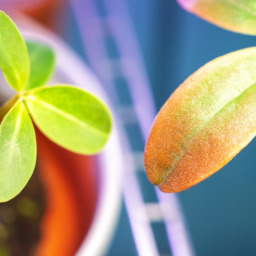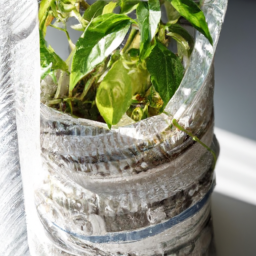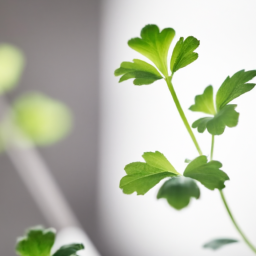
Are you tired of seeing your indoor plants struggle to thrive? Do you dream of having lush, vibrant foliage that brings life and beauty to your living space? Well, you’re in luck! In this blog post, we will explore the wonders of indoor growing lights and how they can help you achieve the vibrant plants you’ve always wanted. With the right lighting, you can create an optimal environment for your plants to flourish, regardless of the limited natural light available indoors. So, let’s dive in and discover how you can transform your indoor garden into a lush oasis using the power of indoor growing lights.
Benefits of Indoor Growing Lights for Vibrant Plant Growth
Indoor gardening has become increasingly popular among plant enthusiasts, allowing them to create lush and vibrant green spaces within the comfort of their own homes. One key element that plays a crucial role in achieving vibrant plant growth indoors is the use of indoor growing lights. These artificial light sources mimic the natural sunlight that plants need to thrive, providing them with the necessary energy for photosynthesis. In this article, we will explore the numerous benefits of indoor growing lights and how they contribute to vibrant plant growth.
Enhanced Photosynthesis
Indoor growing lights, such as LED or fluorescent lights, emit specific wavelengths of light that are essential for photosynthesis. Unlike traditional incandescent bulbs, which produce a broad spectrum of light, indoor growing lights can be tailored to provide the optimal light spectrum for plant growth. By adjusting the light spectrum to match the specific needs of different plant species, indoor gardeners can maximize photosynthesis and promote vibrant growth.
Furthermore, indoor growing lights can be positioned close to the plants, ensuring that they receive an adequate amount of light. This proximity allows plants to absorb more light energy, resulting in increased photosynthetic activity. As a result, plants can produce more glucose, which is the primary source of energy for growth and development.
Additionally, indoor growing lights can be used to extend the duration of light exposure. Unlike natural sunlight, which is limited to a certain number of hours per day, indoor growing lights can be operated for longer periods. This extended light exposure further enhances photosynthesis, allowing plants to thrive and achieve vibrant growth even in environments with limited natural light.
Year-Round Cultivation
Another significant benefit of indoor growing lights is the ability to cultivate plants year-round, regardless of the external climate or season. In regions with harsh winters or limited sunlight, indoor gardening provides a solution to continue plant cultivation without interruption. By utilizing indoor growing lights, gardeners can create a controlled environment that mimics the ideal growing conditions for their plants.
With the right combination of light intensity, duration, and spectrum, indoor gardeners can manipulate the growth cycle of plants. This means that plants can be induced to flower or fruit at any time of the year, allowing for a continuous harvest. The ability to grow plants year-round not only provides a steady supply of fresh produce but also enables gardeners to experiment with different plant varieties and explore new gardening techniques.
Moreover, indoor growing lights offer flexibility in terms of plant placement. Whether you have limited space or live in an apartment with no access to outdoor areas, indoor gardening with the help of growing lights allows you to transform any corner of your home into a vibrant green oasis. From kitchen countertops to dedicated grow rooms, the possibilities are endless.
Promotes Healthy Plant Growth
Indoor growing lights not only provide the necessary light for photosynthesis but also contribute to overall plant health. By using indoor growing lights, gardeners can control the intensity and duration of light exposure, ensuring that plants receive optimal conditions for growth.
One advantage of indoor growing lights is the ability to adjust the light spectrum to meet the specific needs of different plant species. For example, plants that require more blue light for vegetative growth can be provided with a higher proportion of blue light, while those in the flowering stage may benefit from increased red light. This customization allows gardeners to optimize plant growth and achieve vibrant foliage, abundant blooms, and healthy fruits.
Furthermore, indoor growing lights can help prevent common issues associated with indoor gardening, such as leggy or spindly growth. Insufficient light or light coming from a single direction can cause plants to stretch towards the light source, resulting in weak stems and poor overall structure. By strategically placing indoor growing lights and providing uniform light distribution, gardeners can promote sturdy and compact growth, leading to healthier and more vibrant plants.
In conclusion, indoor growing lights offer numerous benefits for achieving vibrant plant growth. From enhancing photosynthesis and enabling year-round cultivation to promoting healthy plant growth, these artificial light sources play a crucial role in creating thriving indoor gardens. By harnessing the power of indoor growing lights and providing plants with the optimal light spectrum, intensity, and duration, gardeners can enjoy the beauty and rewards of vibrant, flourishing plants within their homes.

Choosing the Right Indoor Growing Lights for Optimal Plant Health
Welcome to our guide on achieving vibrant plants with indoor growing lights. In this article, we will explore the importance of choosing the right indoor growing lights for optimal plant health. Whether you are a beginner or an experienced indoor gardener, understanding the different types of lights available and their impact on plant growth is crucial for successful cultivation. Let’s dive in!
The Importance of Indoor Growing Lights
Indoor growing lights play a vital role in providing the necessary light spectrum for plants to thrive indoors. Unlike outdoor plants, indoor plants do not have access to natural sunlight, which is essential for photosynthesis. Therefore, it becomes crucial to mimic the natural light conditions as closely as possible using artificial lighting sources.
When selecting indoor growing lights, it is important to consider the specific needs of your plants. Different plants have varying light requirements, including intensity, duration, and spectrum. By understanding these factors, you can choose the right indoor growing lights to ensure optimal plant health and growth.
Now, let’s explore the different types of indoor growing lights available and their suitability for various plants.
Types of Indoor Growing Lights
1. Fluorescent Lights: Fluorescent lights are a popular choice among indoor gardeners, especially for beginners. They are affordable, energy-efficient, and provide a wide spectrum of light suitable for most plants. There are two main types of fluorescent lights: T5 and compact fluorescent lights (CFL). T5 lights are more efficient and produce a higher light intensity, making them ideal for plants in the vegetative stage. CFL lights, on the other hand, are more compact and suitable for smaller spaces or seedlings.
2. LED Lights: LED lights have gained significant popularity in recent years due to their efficiency and versatility. LED lights are available in a wide range of spectrums, allowing you to customize the lighting conditions based on your plants’ specific needs. They are long-lasting, produce less heat, and consume less energy compared to other types of lights. LED lights are suitable for all stages of plant growth, from seedlings to flowering.
3. High-Intensity Discharge (HID) Lights: HID lights are known for their high light intensity, making them an excellent choice for plants in the flowering stage. There are two main types of HID lights: metal halide (MH) and high-pressure sodium (HPS). MH lights emit a bluish-white light spectrum, which promotes vegetative growth, while HPS lights emit a reddish-orange spectrum, ideal for flowering and fruiting stages. However, HID lights can be more expensive to purchase and operate, and they generate more heat, requiring proper ventilation.
Choosing the Right Indoor Growing Lights
When selecting the right indoor growing lights for your plants, consider the following factors:
1. Light Spectrum: Different plants have different light spectrum requirements. Research the specific light spectrum needs of your plants and choose lights that provide the appropriate spectrum for each growth stage.
2. Light Intensity: Light intensity is crucial for plant growth. Ensure the chosen lights can provide sufficient intensity for your plants, especially during the flowering stage when they require higher light levels.
3. Energy Efficiency: Consider the energy efficiency of the lights. LED lights are known for their energy-saving capabilities, making them a cost-effective choice in the long run.
4. Heat Output: Some lights, such as HID lights, generate more heat than others. Make sure you have proper ventilation and cooling systems in place to prevent heat stress on your plants.
5. Budget: Set a budget for your indoor growing lights. While it is tempting to opt for cheaper options, investing in high-quality lights will yield better results and save you money in the long term.
6. Space: Consider the size of your growing space. If you have limited space, compact lights like CFL or smaller LED panels may be more suitable.
By carefully considering these factors, you can choose the right indoor growing lights that will provide optimal conditions for your plants’ growth and health.
In conclusion, achieving vibrant plants with indoor growing lights requires careful consideration of the different types of lights available and their suitability for your plants. By understanding the specific light spectrum, intensity, and duration requirements of your plants, you can select the right indoor growing lights to mimic natural sunlight and ensure optimal plant health. Remember to consider factors such as energy efficiency, heat output, and your budget when making your choice. Happy gardening!

Tips and Techniques for Achieving Vibrant Plants with Indoor Growing Lights
Indoor gardening has gained immense popularity in recent years, allowing plant enthusiasts to enjoy lush greenery even in the comfort of their own homes. One crucial element for successful indoor gardening is the use of indoor growing lights. These lights simulate natural sunlight and provide plants with the necessary energy for photosynthesis. In this guide, we will explore some tips and techniques to help you achieve vibrant plants with indoor growing lights.
1. Choosing the Right Indoor Growing Lights
The first step in achieving vibrant plants with indoor growing lights is selecting the right type of lights. There are various options available in the market, including fluorescent, LED, and high-intensity discharge (HID) lights. Each type has its own advantages and is suitable for different plant species.
Fluorescent lights are a popular choice for beginners as they are affordable and emit a balanced spectrum of light, suitable for most plants. LED lights, on the other hand, are energy-efficient and can be customized to emit specific wavelengths, promoting optimal growth for different stages of plant development. HID lights are the most powerful and are ideal for large-scale indoor gardens.
Consider the specific needs of your plants, such as their light requirements and growth stage, before selecting the type of indoor growing lights. It’s also essential to choose lights with the right intensity and coverage area to ensure all your plants receive adequate light.
2. Positioning the Lights
The placement of indoor growing lights is crucial for the overall health and growth of your plants. As a general rule, position the lights approximately 6 to 12 inches above the plants to provide them with sufficient light without causing heat stress. However, this distance may vary depending on the type of lights you are using.
Consider the height of your plants and adjust the lights accordingly to ensure uniform light distribution. If you have multiple shelves or levels in your indoor garden, make sure each level receives adequate light by adjusting the height and angle of the lights. Regularly monitor your plants for any signs of light deficiency or excess, such as stunted growth or burnt leaves, and make necessary adjustments.
It’s also important to rotate your plants regularly to ensure all sides receive equal exposure to light. This prevents the plants from growing unevenly or leaning towards the light source.
3. Light Duration and Intensity
The duration and intensity of light exposure play a crucial role in the growth and development of your plants. Most plants require around 12 to 16 hours of light per day for optimal growth. However, some plants, such as succulents or cacti, may require shorter durations of light exposure.
Invest in a timer to automate the light cycle and ensure consistent light exposure for your plants. This eliminates the risk of forgetting to turn the lights on or off, which can disrupt the plants’ growth patterns.
Additionally, consider the intensity of light required by your plants. Different stages of plant growth require varying light intensities. For instance, seedlings and young plants typically require higher light intensities to promote healthy growth, while mature plants may thrive with slightly lower intensities.
Monitor your plants closely and observe their response to light. If you notice signs of light stress, such as wilting or yellowing leaves, adjust the light intensity accordingly. On the other hand, if your plants appear leggy or stretched, it may indicate insufficient light intensity, and you should increase it gradually.
Remember, achieving vibrant plants with indoor growing lights requires careful observation and adjustments to meet the specific needs of your plants.
By choosing the right type of lights, positioning them correctly, and ensuring appropriate light duration and intensity, you can create an ideal environment for your indoor plants to thrive. Enjoy the beauty of lush greenery and the satisfaction of successfully nurturing vibrant plants with the help of indoor growing lights.
Key Takeaways of this article
Are you tired of your indoor plants looking dull and lifeless? Do you dream of having vibrant, lush greenery in your home all year round? Look no further than indoor growing lights! These amazing devices are the secret weapon for achieving thriving plants indoors.
Indoor growing lights are specially designed to provide the right amount and type of light that plants need to grow and flourish. Unlike regular household lighting, these lights emit a specific spectrum of light that mimics natural sunlight. This means that even if you have limited access to natural light in your home, you can still give your plants the light they crave. Whether you have a small herb garden in your kitchen or a collection of tropical plants in your living room, indoor growing lights can help you create the perfect environment for your plants to thrive.
Not only do indoor growing lights provide the necessary light for plant growth, but they also offer other benefits. For instance, they can help regulate the temperature around your plants, ensuring they stay at the optimal temperature for growth. Additionally, they can extend the growing season, allowing you to enjoy fresh herbs and vegetables all year round. With indoor growing lights, you can say goodbye to sad, lackluster plants and hello to vibrant, healthy greenery in your home!
Q&A Corner:
Q1: How do indoor growing lights help achieve vibrant plants?
A1: Indoor growing lights provide the necessary light spectrum and intensity for plants to thrive indoors. They mimic natural sunlight, ensuring that plants receive the right amount of light for photosynthesis, which is essential for their growth and vibrant appearance.
Q2: What are the benefits of using indoor growing lights?
A2: Using indoor growing lights offers several benefits. Firstly, they allow you to grow plants indoors, regardless of the season or weather conditions. Secondly, these lights provide a consistent light source, ensuring that your plants receive the necessary light even in low-light areas. Lastly, indoor growing lights can be customized to meet specific plant requirements, optimizing their growth and vibrancy.
Q3: What types of indoor growing lights are available?
A3: There are various types of indoor growing lights available, including fluorescent lights, LED lights, and high-intensity discharge (HID) lights. Each type has its advantages and is suitable for different plant species and growth stages. LED lights are energy-efficient and versatile, while HID lights are powerful and ideal for larger plant setups.
Q4: How do I choose the right indoor growing lights for my plants?
A4: When choosing indoor growing lights, consider factors such as the type of plants you’re growing, their growth stage, the available space, and your budget. LED lights are generally a popular choice due to their versatility and energy efficiency. It’s also helpful to consult with experts or refer to plant-specific lighting guidelines to ensure you select the most suitable lights for your plants’ needs.
Q5: Are indoor growing lights safe to use?
A5: Yes, indoor growing lights are safe to use when used properly. However, it’s important to follow the manufacturer’s instructions and safety guidelines. Avoid leaving the lights on for extended periods without breaks, as plants also require periods of darkness. Additionally, ensure proper ventilation and avoid placing lights too close to plants to prevent overheating or burning.
Dr. Olivia Green is a botanist with over two decades of experience in indoor plant cultivation. She holds a Ph.D. in Plant Biology and has dedicated her career to researching plant behavior in controlled environments. Dr. Green is passionate about helping plant enthusiasts master the art of indoor gardening through her extensive knowledge and practical insights.


